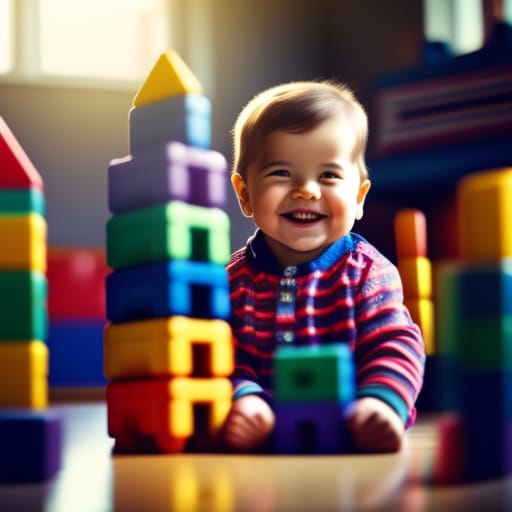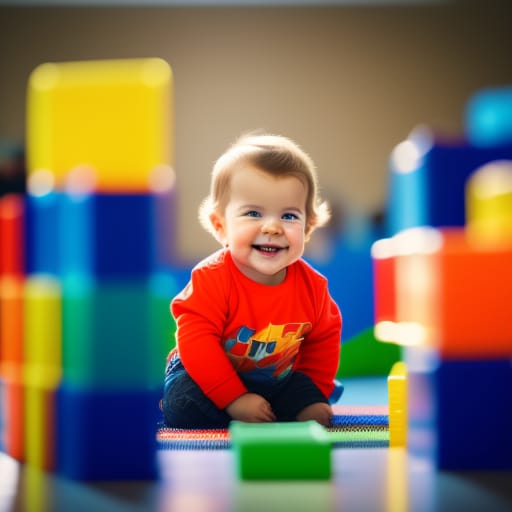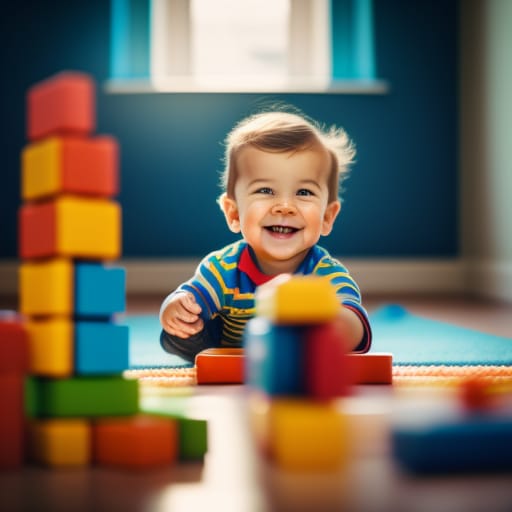Building toys like blocks, Lego, and other construction toys have been staples of playrooms for generations. More than just fun distractions, building toys offers a wealth of developmental and educational benefits for children. As tools for open-ended play and creativity, building toys supports cognitive, motor, social-emotional, and communication skills.
This beginner’s guide will explore the significance of building toys and blocks. You’ll learn:
- The history and educational impact of building toys
- Key developmental and learning benefits of block play
- An overview of the building toys market
- How building toys align with early childhood education goals
- Tips for integrating building toys into learning activities
Whether you’re a parent looking to enrich your child’s play or an early childhood educator searching for hands-on learning tools, this guide will illustrate why building toys should be part of every playroom and classroom.

A Definition and History of Building Toys
Building toys refer to any play materials designed for constructing, creating, and modeling. Simple wooden blocks, Lego, foam building blocks, Magformers, and Magnetiles are all examples of building toys. These open-ended toys come in many shapes, sizes, and materials but share a common function – to encourage building.
Children as young as toddlers begin playing with building toys by stacking blocks and knocking them down. As they grow, preschoolers and school-age children combine building toys to create elaborate constructions and express creativity. The open-ended nature of these toys allows for ongoing challenges as children build more complex structures.
Versions of building blocks and construction toys have existed for centuries. Archaeological evidence suggests ancient Greek and Roman children played with carved wooden blocks. In the 1800s, innovators like Friedrich Froebel, Maria Montessori, and Charles and Frank Wright helped popularize building blocks made from rubber, paper, and wood.
The 20th century brought about plastic building bricks, beginning with the Lego company in Denmark. Since the 1950s, Lego has dominated the building toys market with its interlocking plastic bricks and minifigures. Lego represents just one example of how building toys evolved from simple wooden blocks into the vast array of construction toys available today.
Why Do Building Toys Matter for Child Development?
Open-ended building toys present infinite possibilities for constructive play. As children build, create, and roleplay with building toys, they support developmental growth across multiple domains:
Cognitive development – Building toys helps children develop spatial reasoning, hand-eye coordination, problem-solving skills, and concept knowledge related to shapes, colors, patterns, numbers, and letters.
Social-emotional development – Playing cooperatively with building toys enables children to share ideas, negotiate roles, and gain confidence.
Language and literacy skills – Building toys inspires storytelling, enriches vocabulary, and promotes reading readiness skills.
Mathematical thinking – Construction play builds early STEM abilities like estimation, measurement, patterning, geometry, and quantity skills.
Fine motor skills – Assembling and manipulating building toys strengthens fine motor control and dexterity.
Decades of research highlight the cognitive, social, motor, literacy, and math benefits of building toy play during early childhood. Their versatility also allows building toys to align with learning standards and curricula. This makes construction toys ideal for both playrooms and early education classrooms.
The Market for Building Toys
The global building toys market size was valued at USD 13.1 billion in 2022. Industry reports project the market will grow steadily at a CAGR of 6% from 2023-2028. This growth reflects the continuing popularity of building toys among children, parents, and educators.
Several factors are driving growth and innovation in the building toys market:
- Increased parental and educator awareness of the benefits of open-ended construction play
- Focus on developing STEM-related skills from an early age
- Building toys align with hands-on learning methods favored in early childhood education
- Digital integration adds tech elements to enhance building experiences
The market features distinct product segments:
Plastic building blocks – Interlocking plastic bricks like Lego remain top sellers. New licenses and tie-ins with movies/TV drive interest.
Wooden building blocks – Eco-friendly wooden blocks appeal to parents who value natural materials. Large blocks build motor skills.
Foam building blocks – Lightweight, colorful foam blocks suit toddlers. Compatible with plastic blocks.
Educational building sets – Feature letters, numbers, and shapes to teach concepts. Popular for school and home.
Magnet & connector building toys – Enable building in 3D with plastic or metal pieces and magnets/connectors. Brands like Magna-Tiles, Magformers, and Picasso Tiles.
Lego, Fisher-Price, Magna-Tiles, Mega Bloks, People Blocks, HABA, Magformers, and Picasso Tiles rank among the top manufacturers. Private brands also claim market share. As parents increasingly value open-ended play, the building toys market looks poised for continued expansion.
Building Blocks as Essential Learning Tools
Building toys feature prominently in early childhood education frameworks worldwide. Let’s examine key curriculum connections teachers make when introducing building blocks in preschool and early elementary classrooms.
Building Blocks for Preschoolers (Foundation Stage)
The UK Foundation Stage curriculum focuses on six areas of learning for 3-5 year olds. Building blocks tick boxes in several categories:
Communication/language – Support vocabulary building, language comprehension, storytelling
Physical development – Enhance fine motor skills and hand-eye coordination
Personal, social, and emotional development – Allow for sharing, turn-taking, and expressing imagination
Mathematics – Develop understanding of shapes, spatial relationships, size, counting, sorting
Understanding the world – Build knowledge of colors, textures, patterns, and constructions
Expressive arts and design – Inspire pretending, role play, and creativity
In addition to general skills, preschool teachers use blocks purposefully to teach:
- Early literacy – Alphabet blocks, sight word blocks, storytelling with structures
- Math and science – Counting, sorting, shapes, estimating, comparing, gravity
- Social skills – Sharing materials, collaborating on structures
- Motor skills – Stacking, building, manipulating pieces
Building Blocks for Early Primary School (Key Stage 1)
The UK KS1 curriculum for 5-7 year olds also integrates building blocks across subject areas:
English – Language development, storytelling from constructions
Maths – Visualizing shapes, spatial awareness, counting, measuring, comparing sizes
Science – Hands-on exploration of concepts like gravity, friction, balance
Art and design – Encouraging creativity, self-expression, and design thinking
Teachers use blocks in KS1 to teach:
- Literacy and drama – Storytelling from structures, character, and scene creation
- Maths – Patterning, addition/subtraction with blocks, visualizing 3D shapes
- Science – Exploring mass, friction, motion, gravity, and engineering solutions
- Thinking skills – Planning, designing, problem-solving, collaborating
Whether in preschool or early primary school, blocks engage children while supporting curriculum goals. Let’s examine the specific developmental and educational benefits of building toy play.

Key Developmental Benefits of Building Toys
Building toys impacts children across developmental domains. As children progress through stages of block play, they cultivate cognitive, motor, language, social-emotional, and general learning skills.
Enhancing Cognitive Development
Construction play promotes cognitive growth in crucial ways:
- Spatial intelligence – Visualizing and manipulating shapes in 2D and 3D builds spatial reasoning ability.
- Cause and effect – Discovering what structures are stable versus unstable teaches principles of gravity, balance, and shape.
- Problem-solving – Challenges like making tall towers or unique designs exercise critical thinking and planning skills.
- Organization – Grouping blocks by color, size, or shape establishes organizational habits.
- Focus and persistence – Sustaining attention on detailed building projects strengthens concentration and self-motivation.
- Creativity – Open-ended play with blocks allows imagination to flourish.
Educators observe how block play stretches children’s planning, reasoning, and critical thinking in self-directed ways. Constructing with blocks is a multi-faceted cognitive activity.
Enhancing Motor Skills
Building intricate structures with blocks develops fine motor skills:
- Precision grasp – Pincer fingers learn to grasp and manipulate pieces.
- Hand-eye coordination – Hands and eyes work together to align edges and construct models.
- Bilateral coordination – Block play integrates both left and right hands.
- Finger dexterity – Navigating small pieces to assemble structures improves finger control.
- Strength and endurance – Sustained building play works on finger, hand, and arm stamina.
As motor skills improve, children can take on more complex constructions. The active, tactile nature of blocks makes them ideal tools for strengthening hand and finger dexterity.
Supporting Social-Emotional Growth
The social nature of sharing blocks allows children to gain vital skills:
- Sharing – Cooperating to build together teaches negotiation and compromises.
- Communication – Conversing while building promotes using language to share ideas.
- Collaboration – Working towards group goals like large constructions builds teamwork.
- Confidence – Having ideas realized in structures boosts self-esteem and creative identity.
- Emotional regulation – Block play provides a comforting, focused activity for developing independent play.
Teachers value block play for nurturing positive social interactions and problem-solving. Constructing together helps children learn to share ideas, materials, and successes.
Building Early Literacy Abilities
Educators capitalize on blocks to strengthen emerging literacy skills:
- Oral language – Describing structures and collaborating on designs grows vocabulary and conversational abilities.
- Storytelling – Creating block scenarios facilitates imaginative narratives and comprehension.
- Print concepts – Playing with letter and word blocks familiarizes children with how print works.
- Motivation – Interest in manipulating blocks makes children eager to learn from these hands-on toys.
- Phonological awareness – Rhyming and clapping out syllables with blocks connects sounds to meaning.
Literacy permeates block play, from increasing oral fluency to introducing concepts of print. Children intuitively explore foundational language abilities while immersed in the constructive fun of blocks.
Fostering Mathematical Achievement
Building toys hold mathematical learning potential:
- Spatial relations – Understanding how shapes fit together in 2D or 3D builds spatial reasoning.
- Counting – Counting blocks, spaces, windows, doors, and wheels promotes rote counting ability.
- Shapes – Identifying and creating flat and solid shapes strengthens geometry knowledge.
- Patterns – Repeating block sequences by color, size, or design teaches early patterning skills.
- Measurement – Comparing lengths and sizes of block structures introduces estimation and measurement.
- Symmetry – Creating symmetrical block designs showcases the early math concept of symmetry.
Young children explore sophisticated mathematical concepts through seemingly simple block play. Constructing models yields opportunities to count, sort, pattern, categorize, estimate, and create symmetrical designs.
Maximizing the Benefits of Building Toys
While free block play has value, purposeful guidance, and block introductions enhance the experience. Combining open exploration with thoughtful direction allows children to gain the most from building toys.
Tips for Block Play at Home
Parents can amplify learning with blocks through child-led play supported by adult scaffolding:
- Allow for unstructured building time, but also participate in construction.
- Narrate your child’s process to describe steps, methods, problems, and solutions.
- Ask open questions about structures – “How did you make that tall tower stay up?”
- Introduce new challenges like using certain shapes or making symmetrical structures.
- Use blocks for movement games like stacking blocks on body parts.
- Make letter or word block games to spell names and build phonics skills.
- Encourage elaboration on creations by telling stories and describing scenarios.
- Display finished structures proudly before taking them apart to build something new.
Blending child autonomy with strategic adult input enhances the developmental payoff of block play at home.
Classroom Block Activities and Lessons
Teachers can optimize the learning potential of blocks through thoughtful lesson planning:
- Structured challenges – Give specific building goals based on curriculum objectives. Ex: “Build something with 4 wheels that moves.”
- Small group builds – Have 3-4 children collaborate on a structure to teach teamwork.
- Link to literature – Read a storybook, then have kids build scenes from the narrative.
- Display vocabulary – Have children build models of vocabulary words for language learning.
- Math and science concepts – Teach counting, sorting, patterns, symmetry, gravity, balance, and estimation through block constructions.
- Problem-solving – Present issues like building the tallest tower and letting children engineer solutions.
- Writing prompts – Have students write a story about their completed structure.
With purposeful direction and integration across the curriculum, educators leverage blocks in impactful ways.
The Best Building Toys for Different Ages
While all building toys offer open-ended play, some sets work better for certain ages based on motor skills and interests. Use this quick guide to select age-appropriate building toys:
Toddlers (1-3 years) – Large, basic wooden blocks, mega blocks, foam blocks. Focus is grasping, stacking, and knocking down.
Preschoolers (3-5 years) – Medium interlocking blocks, chunky plastic blocks, magnetic blocks. Develops more elaborate construction. Add themed sets like animals, vehicles, and buildings.
Early elementary (5-7 years) – Lego, building kits, engineering sets. Manipulative skills allow complex structures. Opt for kits that suit their interests.
Older children – Lego, construction kits, K’nex, robotics sets. Complex builds, following instructions, and interests drive play.
While all ages benefit from open-ended blocks, matching toys to skills and interests optimizes enjoyment and expands possibilities.
Fun Building Toy Ideas and Recommendations
With so many options available, here are 12 of the best-selling and highest-rated building toys to consider:
For toddlers:
- Mega Bloks 80-piece Big Building Bag – chunky blocks in bright colors, storage bag, $15
- Melissa & Doug 40-piece Solid Wood Block Set – high-quality wooden blocks to stack and build, $25
- Grimm’s Large Rainbow Wooden Block Set – 28 large colorful wooden pieces, $33
- Edushape Soft Building Blocks – light, squeezable foam blocks for early builders, $22
For preschoolers:
- LEGO Classic Large Creative Brick Box – 484-piece Lego set for open-ended building, $40
- Magna-Tiles 32-Piece Clear Colors Set – magnetic building tiles spark creativity, $49
- PicassoTiles 60-piece 3D Magnetic Building Tiles – build vertically with these magnetic tiles, $50
- Lakeshore Learning Building Block Center – 240-piece set with wheels, windows, and animals, $50
- Magformers 30-piece Basic Set – magnetic shapes and construction ideas, $30
For early elementary:
- LEGO City Fire Chief Vehicle Set – build a fire truck with simple directions, $10
- K’Nex 35 Model Building Set – rods and connectors for 35+ creations, $30
- Magna-Qubits – build 3D creations with magnetic cubes, $70
- LEGO Creative Building Set – 294-piece Lego brick set for open-ended play, $25
- Magna-Tiles Illuminated – light up magnetic tiles for imaginative building, $50
With so many avenues for open-ended play, building toys stimulates children’s bodies and minds in meaningful ways. Integrate them into your home or classroom to unleash the inner architect in every child!

The Educational Significance of Building Toys
Children gain a multitude of developmental and academic benefits from constructing with blocks and other building toys. These versatile materials deserve a central place in early education environments.
Building toys represent inclusive, multisensory, open-ended tools suitable for all ages and abilities. Children explore math, literacy, science, and social concepts intuitively through the simple act of block play. Targeted lessons take learning even further.
As educators continue recognizing the immersive qualities of building toys, these classroom staples will propel interactive learning long into the future. Children gravitate to building toys across generations for a reason – imagination and education go hand-in-hand when children play with blocks!
Frequently Asked Questions About Building Toys
- What are the benefits of construction play?
Construction play with building toys provides immense cognitive, social, motor, and educational benefits. Building toys helps develop children’s spatial reasoning, math skills, fine motor control, problem-solving, language abilities, and creativity. The open-ended play they encourage also supports social-emotional learning and academic concepts.
- How do building toys encourage creative thinking?
The open-ended nature of most building toys allows endless possibilities for children to use divergent thinking and imagination. Rather than dictating what to create, building toys empowers creative exploration. Children are free to experiment and express unique ideas through original block constructions.
- What are the best building toys for toddlers?
Look for large, chunky plastic blocks or wooden blocks with no small pieces. Popular options include Mega Bloks, soft blocks, and Melissa & Doug wooden blocks. Avoid tiny Lego pieces, which pose a choking hazard. The focus is on grasping, moving, stacking, and knocking down simple structures.
- How do magnet tiles like Magna-Tiles work?
Magnet tiles feature embedded magnets that allow them to connect to each other in different directions. This opens new possibilities for vertical and 3D building that enhances spatial skills. The tiles stick together securely, yet are easy for little hands to detach. Magnetic blocks introduce early architecture and physics concepts in hands-on ways.
- What developmental benefits do building toys offer?
Building toys provides full-body and minds-on learning that promotes cognitive, social, emotional, fine motor, language, literacy, STEM, and overall school readiness skills. As they construct, children problem-solve, calculate, collaborate, tell stories, and expand creativity. The universal appeal of buildings makes them ideal educational toys.
- How can I use building toys to boost early math skills?
Encourage counting, sorting by size/color, finding matching shapes, creating patterns, recognizing 2D/3D shapes, symmetry, estimation, and measurement. Use terms like taller, shorter, more, less, bigger, and smaller. Let children discover these concepts through hands-on block play.
- Which building toys work for 5-7 year olds?
Bigger Lego sets, Magna-Tiles, Mega Bloks, and building kits allow more elaborate structures at this age. Opt for construction sets related to their interests like cities, vehicles, animals, or licensed themes from movies. K’nex, magnet cubes, and STEM sets also build logic and problem-solving.